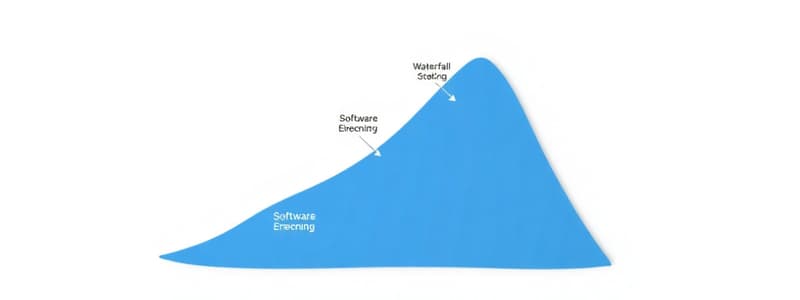Podcast
Questions and Answers
What is the primary focus of the Usability Engineering Life Cycle?
What is the primary focus of the Usability Engineering Life Cycle?
Which activity is central at the beginning of the Usability Engineering process?
Which activity is central at the beginning of the Usability Engineering process?
In the Star Life Cycle Model, how are the stages of development handled?
In the Star Life Cycle Model, how are the stages of development handled?
What is a key benefit of implementing a Hybrid System Development Life Cycle?
What is a key benefit of implementing a Hybrid System Development Life Cycle?
Signup and view all the answers
What is a significant advantage of high usability derived from the Usability Engineering Life Cycle?
What is a significant advantage of high usability derived from the Usability Engineering Life Cycle?
Signup and view all the answers
What is the first stage in the prototyping model?
What is the first stage in the prototyping model?
Signup and view all the answers
Which type of prototyping focuses on exploring user requirements with each iteration?
Which type of prototyping focuses on exploring user requirements with each iteration?
Signup and view all the answers
What is a major advantage of the prototyping model?
What is a major advantage of the prototyping model?
Signup and view all the answers
In the prototyping model, what happens if users identify necessary changes after testing?
In the prototyping model, what happens if users identify necessary changes after testing?
Signup and view all the answers
Which of the following statements best describes the experimental approach to prototyping?
Which of the following statements best describes the experimental approach to prototyping?
Signup and view all the answers
The evolutionary approach in prototyping is closest to which lifecycle model?
The evolutionary approach in prototyping is closest to which lifecycle model?
Signup and view all the answers
What is a disadvantage of the prototyping model?
What is a disadvantage of the prototyping model?
Signup and view all the answers
Which of the following is NOT a step in the Agile development process?
Which of the following is NOT a step in the Agile development process?
Signup and view all the answers
What is emphasized in the Agile Life Cycle Model during the construction iterations?
What is emphasized in the Agile Life Cycle Model during the construction iterations?
Signup and view all the answers
What is a key characteristic of the spiral model of prototyping?
What is a key characteristic of the spiral model of prototyping?
Signup and view all the answers
How does the Agile Life Cycle Model typically handle changing requirements?
How does the Agile Life Cycle Model typically handle changing requirements?
Signup and view all the answers
Which characteristic is highlighted as a significant advantage of the Agile Life Cycle Model?
Which characteristic is highlighted as a significant advantage of the Agile Life Cycle Model?
Signup and view all the answers
What is a primary focus of the Prototyping Model?
What is a primary focus of the Prototyping Model?
Signup and view all the answers
During which stage of the Agile model is final testing of the entire system conducted?
During which stage of the Agile model is final testing of the entire system conducted?
Signup and view all the answers
What type of teams are considered the best form of project development in Agile?
What type of teams are considered the best form of project development in Agile?
Signup and view all the answers
Which of the following best explains the notion of simplicity in the context of Agile?
Which of the following best explains the notion of simplicity in the context of Agile?
Signup and view all the answers
What is the first phase of the conventional life cycle in SDLC?
What is the first phase of the conventional life cycle in SDLC?
Signup and view all the answers
Which principle of the Waterfall Model emphasizes the importance of documenting the design?
Which principle of the Waterfall Model emphasizes the importance of documenting the design?
Signup and view all the answers
What major drawback does the Waterfall Model have regarding error detection?
What major drawback does the Waterfall Model have regarding error detection?
Signup and view all the answers
How does the Incremental Model differ from the traditional Waterfall Model?
How does the Incremental Model differ from the traditional Waterfall Model?
Signup and view all the answers
Which of the following is NOT part of the Waterfall Model stages?
Which of the following is NOT part of the Waterfall Model stages?
Signup and view all the answers
What is a major risk associated with the Incremental Model?
What is a major risk associated with the Incremental Model?
Signup and view all the answers
What does IIDM stand for in the context of software development models?
What does IIDM stand for in the context of software development models?
Signup and view all the answers
Which of the following is a characteristic of the Waterfall Model?
Which of the following is a characteristic of the Waterfall Model?
Signup and view all the answers
What is a key characteristic of the Spiral Life Cycle Model regarding risk?
What is a key characteristic of the Spiral Life Cycle Model regarding risk?
Signup and view all the answers
Which of the following is NOT one of the strategic principles of the Spiral Life Cycle Model?
Which of the following is NOT one of the strategic principles of the Spiral Life Cycle Model?
Signup and view all the answers
What are the anchor point milestones mentioned in the Spiral Life Cycle Model?
What are the anchor point milestones mentioned in the Spiral Life Cycle Model?
Signup and view all the answers
What does the V Life Cycle Model emphasize?
What does the V Life Cycle Model emphasize?
Signup and view all the answers
Which of the following statements accurately describes a limitation of the Spiral Life Cycle Model?
Which of the following statements accurately describes a limitation of the Spiral Life Cycle Model?
Signup and view all the answers
What defines the 'invariants' in the Spiral Life Cycle Model?
What defines the 'invariants' in the Spiral Life Cycle Model?
Signup and view all the answers
At which stage does the V Life Cycle Model start its process?
At which stage does the V Life Cycle Model start its process?
Signup and view all the answers
What is the main purpose of the Spiral Life Cycle Model's risk assessment process?
What is the main purpose of the Spiral Life Cycle Model's risk assessment process?
Signup and view all the answers
Study Notes
Information System Development Life Cycle (SDLC) Models
- SDLC encompasses the entire lifespan of an information system, from creation to termination. It includes stages like requirements, analysis, design, construction, testing, installation, operation, maintenance, and retirement.
- The conventional SDLC model has five phases: Investigation, User Requirements, Analysis, Design, Implementation, and Release.
- There are diverse SDLC models, each with its own strengths and weaknesses, tailored to project requirements.
- Waterfall Model: A classical, sequential approach where each phase must be completed before moving to the next. Known for its simplicity, but lacks flexibility and suffers from late detection of errors.
Waterfall Model Key Principles:
- Program design is prioritized.
- Design documentation is crucial.
- Multiple iterations of design are encouraged.
- Thorough planning, controlling, and monitoring of testing are vital.
- Client involvement throughout the project is essential.
Incremental Model:
- Development is broken into smaller increments, each building upon the previous one.
- Allows for feedback from clients early in the process.
- Offers greater flexibility and adaptability to changing requirements.
- Can be more costly due to multiple releases.
- Compatibility issues between versions may arise.
Iterative and Incremental Development Model (IIDM):
- Similar to the Incremental Model but emphasizes the relationships between each increment.
- Provides a more fluid description of development.
- Allows for significant feedback from clients.
Spiral Life Cycle Model:
- Combines elements from Waterfall, Incremental, and Evolutionary Prototyping models.
- Involves a series of cycles or iterations.
- Risk assessment is a crucial aspect of each cycle.
- Emphasizes the importance of concurrent artifact definition.
Spiral Life Cycle Model Invariants:
- Concurrent definition of key artifacts.
- Each cycle utilizes four strategic principles: determine objectives, evaluate risks, develop and test, and plan the next iteration.
- The level of effort is determined by risk considerations.
- The level of detail is driven by risk considerations.
- Anchor point milestones include Life Cycle Objectives (LCO), Life Cycle Architecture (LCA), and Initial Operational Capability (IOC).
- The development process should focus on the overall life cycle.
V Life Cycle Model:
- Emphasizes the connection between development stages and their corresponding testing stages.
- Each stage is checked and approved before moving to the next.
- Follows a top-down approach, starting with analysis and ending with coding.
- Promotes sustainable development, technical quality, and simplicity.
- Encourages self-organizing teams for project development.
Agile Life Cycle Model:
- Employs an iterative and incremental approach, focusing on collaboration and rapid feedback.
- Has numerous subvariations like Scrum and XP.
- Consists of four steps:
- Project selection and approval.
- Project initiation.
- Construction iterations.
- Product release.
Agile Life Cycle Model Advantages:
- Faster product development.
- Collaborative effort and documentation.
- Flexibility and adaptability to changing requirements.
- High client satisfaction and user-friendliness.
- Reduced error margins.
- Ability to meet rapidly changing requirements.
Prototyping Model:
- A user-centric approach that involves creating a working prototype of the system, which is then refined based on user feedback.
- Offers a more iterative and flexible development process.
- Can be viewed as a part of a larger SDLC or as the central approach itself.
Prototyping Model Stages:
- User requirements and needs are analyzed.
- A working prototype is developed.
- The prototype is implemented and tested by users.
- The prototype is revised and refined based on user feedback.
Types of Prototyping:
- Exploratory approach: Emphasizes exploring and understanding requirements with each iteration.
- Experimental approach: Proposes a solution and evaluates it through experimental use.
- Evolutionary approach: Develops the product in successive versions, with each version serving as a prototype for the next.
Prototyping Model Advantages:
- Adaptation to changing requirements.
- High probability of success and low risks.
- Shorter development time frame.
Prototyping Model Disadvantages:
- Weak on analysis and design planning.
- Limited control over costs and resources.
Usability Engineering Life Cycle (UELC):
- Primarily focuses on user interface design.
- Applies structured iterative design and evaluation to all stages of the SDLC.
- Emphasizes determining the product’s user base.
- Utilizes user task analysis to understand user needs.
- Aims for financially effective, highly usable systems.
UELC Advantages:
- High usability and user-friendliness.
- Prevention of errors due to human misuse of the interface.
- Increased productivity.
UELC Disadvantages:
- Requires specialized knowledge and skills.
Star Life Cycle Model:
- Each development step can be processed in various orders and time frames.
- Stages can be repeated or skipped based on project needs.
- Places users at the center of the development cycle.
Hybrid System Development Life Cycles:
- Combine elements of multiple SDLC models to overcome their limitations.
- Enhance strengths and mitigate weaknesses.
Studying That Suits You
Use AI to generate personalized quizzes and flashcards to suit your learning preferences.
Related Documents
Description
Explore the stages and models of the Software Development Life Cycle (SDLC) in this quiz. Learn about the conventional SDLC phases and the strengths and weaknesses of different models, particularly the Waterfall Model. Test your understanding of key principles and practices in program design and project management.




